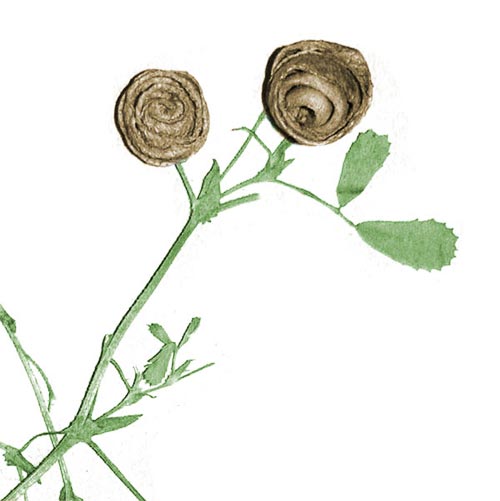Relatives
Medicago scutellata (L.) Mill. - Shield shaped alfalfa
Taxonomic position.
Family Leguminosae Endl., genus Medicago L., subgenus Spirocarpos Grossh.Biology and morphology.
2n=32. Annual. Plant grows up to 60 cm tall. Stems thin, numerous, prostrate to decumbent, secondary branching along their whole length, densely covered with glandular and simple hairs. Leaflets glabrous, 15-20 mm x 8-12 mm, elliptical to obovate, margin serrated almost to the base. Peduncle 1-3-flowered, shorter than corresponding petiole. Flowers orange-yellow, 5.0-6.5 mm long. Pods cups-shaped, 16 mm in diameter with 5-6 coils, turning clockwise, spineless. Blossoms in April-June; seeds ripening in May-June. Self-pollinated.Distribution.
Occurs throughout Southern Europe, Asia Minor, northern Africa, central and southern Ukraine, and the Crimea.Ecology.
Occurs in steppe meadows, along wood edges, and sometimes as a weed in fallow fields and gardens. Prefers heavy soils.Utilization and economic value.
Very promising forage plant for improving pastures in southern areas. Characterized by high seed productivity in unfavorable years. Drought- and heat-resistantLiterature cited.
Goncharov P.L., Lubenetc P.A. 1985. Biological Aspects of Alfalfa Cultivating. Novosibirsk, Nauka, p. 253.Grossheim A.A. 1952. Medicago genus. Flora of the Caucasus. Vol. 11, pp. 129-176.
Grossheim A.A. 1945. Genus Medicago. Flora of the USSR. Vol. 11. M.-L.: USSR, p. 129-176. (in Russian).
Lesins K.A., Lesins I. 1979. Genus Medicago (Leguminosae). A Taxogenetic study, p. 228.
Sinskaya E.N. 1950. Alfalfa. Cultural Flora of the USSR. Vol. 13, issue 1, pp. 1-344.


